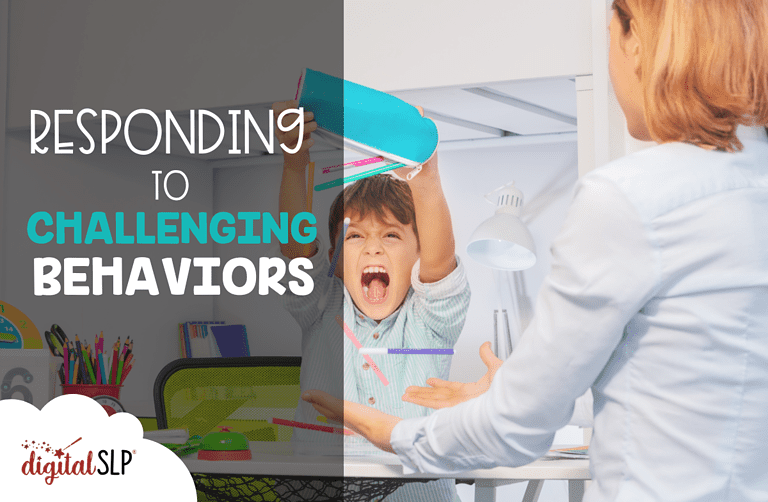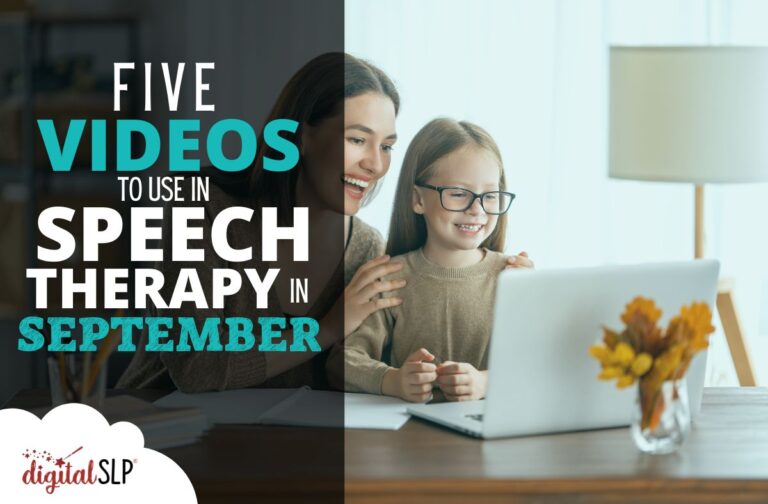June is around the corner, and summer is so close! I hope this new set of video recommendations will help you enter the sunny season in style.
Just a quick reminder: I watched all of these videos and found them to be worthwhile, but everyone’s needs are different, so please preview any video before sharing it with students.
Let’s check out these videos!
Length: 9 minutes
Ages: 1st–8th grade
This video will give students plenty to think about if they’re headed to the beach this summer, and it’s a must-watch for World Reef Day on June 1st or World Ocean Day on June 8th. Using accessible language, it explains the science behind vibrant reefs, shares a sobering picture of what happens when reefs are unhealthy, and then ends on a hopeful note.
Here are some speech therapy targets to pair with this thought-provoking video:
- Basic concepts: The whole video bursts with color, inviting students to name all of the hues they see. Students could also discuss shapes, sizes, and locations. (For very young students, you may want to mute the video and just share a few moments of footage.)
- Compare and contrast: Early in the video, the narrator explains some of the similarities between corals and jellyfish. Students could brainstorm additional similarities, as well as differences.
- Summarizing: As this video demonstrates, there are complex reasons for a coral reef’s bright colors. Near the end of the video, the narrator gives a helpful recap of these reasons, which serves as an excellent model for how to create a summary.
- Vocabulary: This video uses many functional Tier II words, including “thrive,” “elaborate,” “produce,” “survive,” “benefit,” “effect,” and “dramatic” (there are also plenty of ocean-focused Tier III words!).
- Extension: Students could select any topic from the video to explore in depth. I know I’m excited to learn more about coral nurseries!
Length: 12 minutes total, including bonus pinwheel craft instructions (the story ends at 7:30)
Ages: 2nd–8th grade
I featured this true story of perseverance in a subscriber email several months ago, and to honor Global Wind Day on June 15th, I wanted to share it with the blog community as well. In The Boy Who Harnessed the Wind, young William Kamkwamba (who wrote this book with coauthor Bryan Mealer) observes the devastating effects of famine in his home country of Malawi, and takes action by building a windmill, using scrap parts and instructions from a library book.
Harness the power of this incredible story and use it to teach:
- Context clues: When students encounter words from the Chichewa language sprinkled throughout the text, they could use context clues to try and figure out their meanings.
- Figurative language: The Boy Who Harnessed the Wind has metaphors (“alone with the monster in his belly”), similes (“wobbled like a clumsy giraffe”), and personification (“the sun rose angry each morning”), offering students an opportunity to learn about these language forms.
- Multiple-meaning words: Students could identify some of the multiple-meaning words (e.g., “drawing,” “bearing,” “cap,” “bolted”) found in the book, and consider all of the different ways to use them.
- Social-emotional learning: When Kamkwamba was working on his windmill, some villagers made disdainful comments about his project as they passed by. Students could discuss how it might have felt to hear those remarks, and brainstorm encouraging alternative messages.
- Extension: Kamkwamba’s entrepreneurial spirit inspired the creation of a nonprofit called Moving Windmills and its website is full of resources (including DIY projects and additional videos) for students to explore.
Length: 3 minutes
Ages: Preschool–3rd grade
The dog days of summer will be here soon, and this read-aloud of Doug Salati’s Caldecott Medal-winning picture book is a great way to celebrate! The story follows an overheated dachshund’s journey from wilting in a crowded city to jumping for joy on a breezy beach.
Try using Hot Dog to work on these goal areas:
- Describing: The illustrations are the star of this book–you can almost feel the heat shimmering from the page, and there’s a palpable sense of relief when the dog arrives at the shore. Students could talk about what they see in each picture as they move through the book.
- Parts of speech: Although the language in Hot Dog is minimal, each word packs a punch, with memorable phrases like “steamy sidewalks,” “sirens screech,” “unfolding sky,” and “trains rumble.” Students could look for examples of specific parts of speech, or go through the book and categorize the words they find.
- Personal narrative: After taking a few moments to reflect, students could share about a time when they went on an adventure, or talk about their preferred strategies for staying cool during the summer.
- Perspective-taking: Although this story focuses on the dog’s experience, his human plays an important role as well. Students could use her facial expressions and actions to make inferences about how she feels and what she’s thinking.
- Extension: Students with sensory differences will feel seen by this book, as the city is described as “too close, too loud, too MUCH!” They could talk about the strategies they use in these types of overwhelming situations, and brainstorm additional ideas to add to their toolkits.
Length: 5 minutes
Ages: 9th–12th grade
Deafblind Awareness Week is held during the final week of June each year, both to honor the legacy of Helen Keller (who was born on June 27th, 1880), and to increase global understanding of Deafblindness. This insightful video highlights Deafblind civil rights attorney Haben Girma, who graduated from Harvard Law School in 2013.
The thoughtful topics from this video could be used to address:
- Discussion skills: Girma is a strong believer that disability provides opportunities for innovation. Students could talk about inventions and technology that have helped people with different types of disabilities, or even work together to generate ideas for new inventions.
- Inferences/social-emotional learning: Girma leads a remarkable life (and has a quick wit!). As students learn more about her, they could make inferences about the character traits that have supported her ability to navigate challenges and keep moving forward.
- Predicting: Prior to starting the video, you could explain that it features a person who is Deafblind, and ask students to predict how she engages in conversations.
- Wh-questions: Students could generate questions they would like to ask Girma.
- Extension: There are so many options here! Students who are fascinated by Girma’s Braille tablet may enjoy seeing her use it to converse with a sighted/hearing person in this (delightful) video. Or, they may want to check out Deafblind International’s annual “yarn bombing” campaign, in which volunteers create public yarn art installations.
Length: 3 minutes
Ages: Preschool–2nd grade
June 24th is Upcycling Day, and in this video, the self-proclaimed “reuse grouch” Elmo has lots of ideas for how to turn trash into treasure. But can he inspire that other grouch Oscar to get on the upcycling train? Students will have to watch the video to find out!
As students learn how to help the earth, they can also work on communication skills, including:
- Articulation: Elmo sings a (very catchy) song about reusing, and it has a lot of repetition—after all, as he admits, he even likes to “reuse” lyrics. These repetitions allow for plenty of articulation practice, especially with /ch/, /r/, and /z/.
- Imitating/movement: Students in need of a brain break could wiggle along with Elmo’s movements, or make up their own “reuse dance.”
- Sequencing: During the video, Oscar challenges Elmo to think of how to reuse increasingly challenging items. You could bring in a similar collection of objects and have students follow the steps in the video.
- Social-emotional learning: Although Elmo describes himself as a grouch, there’s nothing grouchy about him, at least in this video! Students could discuss the meaning of the word “grouch,” and identify options for what to do when they’re feeling grouchy.
- Extension: If students are motivated to create their own upcycled projects, they could check out books like Art with Everyday Things. The Digital SLP also has a simple tutorial for upcycled necklaces!
I hope these videos enrich your June speech therapy activities!
If you love using videos in your speech sessions and want weekly recommendations and activity suggestions in your inbox, consider signing up for a Digital SLP membership! This is just one of the many bonuses you receive when you become a paid subscriber. Click here to learn more.













Recent Comments